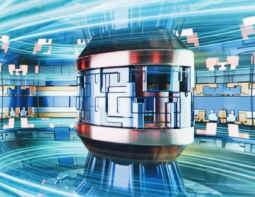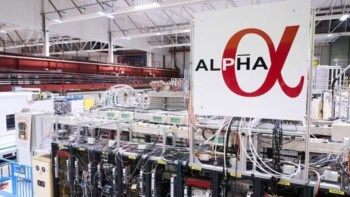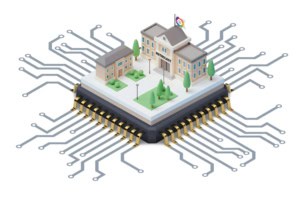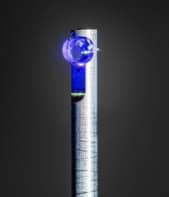A vacuum vessel that can simulate the harsh conditions on our planetary neighbour is an ideal testing ground for space instrumentation. Jesús Sobrado, Juan Manuel Manchado and Jose Angel Martín-Gago explain
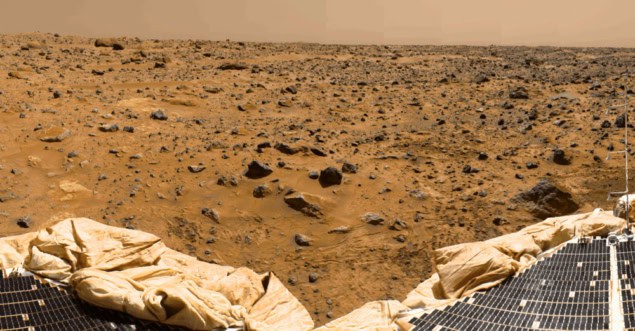
Mars has become an important target for planetary exploration, in part because there are several theories that claim Martian conditions are ideal for prebiotic life. The question of whether life currently exists on Mars, or has existed in the past, is therefore of direct relevance to the origin of life on Earth – and a question that is still very much open.
Since the first successful Mars “fly-by” by NASA’s Mariner 4 mission 50 years ago, there have been more than 40 spaceflights to our planetary neighbour. Although many have ended in failure, these missions have changed our view of Mars. There are several spacecraft currently orbiting the red planet and collecting imaging and spectroscopic data in order to survey the Martian geology and radiation environment. The past decade has also seen several landers and rovers delivered safely to the surface of Mars, which has opened up the potential for further exploration. NASA’s Spirit and Opportunity rovers in particular have sent back stunning pictures of the dusty Martian landscape and collected valuable information about the planet’s potential for supporting life.
Instruments under pressure
The high price of the space missions means that it is vital that instruments perform reliably on the Martian surface. Electronic and mechanical devices that operate under the pressures and temperatures found on Earth will not necessarily work on Mars, where the atmospheric pressure is about 100 times lower and comprises 95% carbon dioxide. The low atmospheric pressure means there are very high levels of UV radiation at the Martian surface, where the temperature varies from 20 °C to –150 °C depending on the latitude, season and time of day. Instruments destined for Mars must therefore be calibrated using the Martian atmospheric parameters as much as possible.
Planetary simulation chambers have become vital for optimizing the functions of onboard space instruments. At the Spanish Astrobiology Centre (CAB, CSIC-INTA) in Madrid, we have recently developed an environmental simulation chamber for testing new electromechanical devices and instruments that could be used on missions to Mars and elsewhere in space. Called MARTE, it is an advanced vacuum vessel designed to regulate surface and environment temperatures, solar radiation, total pressure and atmospheric composition.
Having these capabilities in the same experimental environment gives MARTE several advantages when compared with other chambers – the most important being versatility. MARTE has a modular design that allows its total volume and shape to be modified in order to test instrumentation and samples of different types and sizes. Its pressure ranges from 1000 mbar to 10–6 mbar, while the temperature can range between 108 K and 423 K. The device allows users to simulate solar illumination at different azimuths and UV-radiation levels, while a quadrupole mass spectrometer enables precise control of the gas composition at different pressures.
Testing conditions
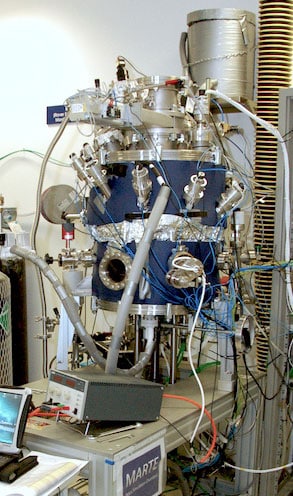
MARTE was first conceived in 2009 and took two years to build. Until now, the chamber has been used primarily to test environmental sensors onboard NASA’s Mars Curiosity rover under real working conditions. This involves calibrating the pressure sensor to provide accurate readings even when sudden pressure variations occur during Martian storms.
MARTE can also simulate dust deposition using a custom-built vibration system. Dust suspended in the Martian atmosphere is one of the most critical meteorological phenomena affecting surface instrumentation. Spacecraft and rovers that have been sent to Mars so far, including Curiosity, have been severely affected by dust accumulating on solar panels and optical instrumentation. To address this problem, we have installed a mechanical system in MARTE that simulates such conditions using dust that has the same colour, chemical composition and density as dust found on Mars. This allowed us to measure the resulting attenuation in the output of UV sensors, for instance, and to evaluate the performance of the sensors as they were operating.
With Mars missions focusing increasingly on the search for extraterrestrial life, we have teamed up with colleagues at CAB to developed the Signs Of Life Detector (SOLID). This instrument analyses soil samples to look for the presence of life based on antibody microarray technology that can detect traces of microorganisms or other biological supra-molecular structures. The detector was placed in MARTE to investigate how it would perform at typical Martian pressures and in a carbon-dioxide-rich atmosphere.
Payload-ready
Some of the parameters that have been optimized to ensure that SOLID will work in future space missions are its electronics, heat-dissipation structures and materials for vacuum that must be able to sustain extreme temperature variations. These tests have been of great relevance for understanding the behaviour of SOLID’s ultrasonic and fluidic systems, for example, and helped us identify the type of pumps and valves required. Thanks to these tests, SOLID is now at an advanced stage that makes it a competitive instrument as a payload for future life-detection missions to Mars.
MARTE will also perform tests for the Mars Environmental Dynamics Analyzer (MEDA) meteorological station, which integrates pressure, wind and humidity sensors and is one of the instruments planned for NASA’s Mars 2020 mission. The Mars 2020 rover will continue with the objective of its predecessor Curiosity to explore the Martian environment for signs of life, and MARTE is an essential platform for validating MEDA instrumentation.
Indeed, one year after its first trials, MARTE’s unique capability to simultaneously control very different atmospheric parameters and to be adapted to different set-ups is proving a crucial tool for all researchers interested in sending instrumentation to the red planet.
